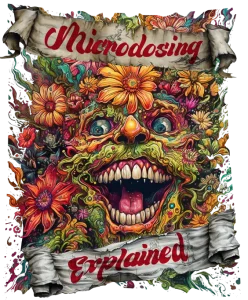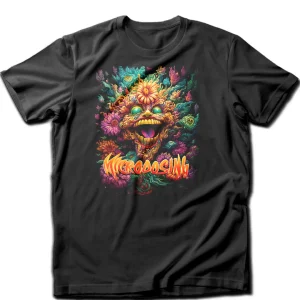In recent years, microdosing psychedelics has gone from a fringe practice to a widely discussed trend, hailed by proponents for its potential to boost creativity, focus, and emotional well-being. As more people become curious about the benefits of microdosing, it’s important to explore the science behind this practice and understand its potential, as well as its limitations.
What Is Microdosing?
Microdosing involves taking very small, sub-perceptual doses of psychedelic substances such as LSD, psilocybin (the active compound in magic mushrooms), or even mescaline. Typically, these doses are about 1/10th to 1/20th of a recreational dose—enough to subtly affect brain function but not enough to induce a full psychedelic trip.
What sets microdosing apart from traditional psychedelic use is the intention behind it. Rather than seeking a hallucinogenic experience, individuals who microdose often do so with the aim of improving cognitive performance, mood, or overall well-being. The idea is to harness the benefits of psychedelics without the intense, mind-altering effects typically associated with them.
The History of Microdosing
While the current wave of microdosing enthusiasm can be traced back to the early 2000s, the practice itself has roots in indigenous cultures that have used psychedelic plants for centuries. Indigenous groups in South America, for instance, have long incorporated psychedelics like ayahuasca and peyote into their spiritual and healing rituals. However, these were typically used in larger doses for ceremonial purposes rather than in microdoses.
The modern concept of microdosing was brought to mainstream attention by Dr. James Fadiman, a psychologist and researcher who began investigating the effects of sub-perceptual doses of psychedelics in the 1960s. Fadiman’s work, particularly his book The Psychedelic Explorer’s Guide, published in 2011, has been pivotal in shaping contemporary discussions around the potential benefits of microdosing.
How Microdosing Works in the Brain
The exact mechanisms by which microdosing affects the brain are still being explored, but research offers some insights. Psychedelics, particularly psilocybin and LSD, interact with serotonin receptors in the brain, specifically the 5-HT2A receptor. This receptor is linked to mood regulation, perception, and cognition.
At full doses, psychedelics induce profound changes in consciousness, including hallucinations, shifts in perception, and altered thought processes. However, at microdoses, the effects are much subtler. The low level of activation still affects brain function, promoting neuroplasticity—the brain’s ability to reorganize itself by forming new neural connections. This increase in neuroplasticity may explain why many people report enhanced creativity, problem-solving abilities, and mood improvements.
Potential Benefits of Microdosing
Although much of the evidence for the benefits of microdosing remains anecdotal, there are several commonly reported advantages by those who practice it:
- Enhanced Creativity: Many individuals, particularly those in creative professions, report that microdosing helps them think more freely, approach problems from new perspectives, and tap into deeper wells of inspiration. This has made microdosing particularly popular in places like Silicon Valley, where innovation is highly valued.
- Increased Focus and Productivity: Another commonly reported benefit is heightened focus and the ability to maintain productivity for longer periods. Microdosing may help eliminate distractions and sharpen mental clarity, making it a tool for those looking to improve their work performance.
- Mood Improvement and Reduced Anxiety: Some users claim that microdosing helps alleviate symptoms of depression and anxiety, even in cases where traditional treatments have failed. While full doses of psychedelics are being researched as potential treatments for mood disorders, microdosing offers a more accessible option for those looking to manage their mental health without the intense effects of a full trip.
Scientific Studies on Microdosing
While personal testimonials abound, scientific research on microdosing is still in its infancy. However, a few studies have begun to shed light on its potential benefits and limitations.
Researchers at Imperial College London, one of the leading institutions studying psychedelics, have conducted placebo-controlled studies to determine whether the reported benefits of microdosing are real or simply placebo effects. Some studies suggest that while microdosing can lead to improvements in mood and cognitive function, the results are often modest and may not be as pronounced as anecdotal reports suggest.
One major challenge in microdosing research is the variability in dosing. Because psychedelics are still illegal in many parts of the world, users often source their substances from the black market, leading to inconsistent doses. Furthermore, the psychological effects of psychedelics can vary widely from person to person, making it difficult to draw firm conclusions from small studies.
Risks and Controversies
As with any emerging trend, microdosing has its risks and controversies. One of the main concerns is the lack of long-term studies on the effects of microdosing. While short-term effects appear to be generally positive, we don’t yet know how regular use of small doses of psychedelics might impact the brain or body over time.
There are also legal risks. In most countries, psychedelics like LSD and psilocybin remain illegal. While some areas, such as Oregon in the U.S., have decriminalized the use of psilocybin, microdosing in places where it’s illegal can still result in legal consequences.
Moreover, some researchers and medical professionals are skeptical about the reported benefits of microdosing. They argue that much of the positive feedback may be attributed to the placebo effect, where individuals experience perceived improvements simply because they believe the substance is helping them.
Personal Experiences and Anecdotal Evidence
Despite the lack of large-scale studies, personal experiences with microdosing are widely shared online and in the media. Many users report noticeable improvements in their daily lives. Artists claim microdosing sparks creativity; entrepreneurs say it enhances their productivity; and others suggest it helps them cope with anxiety or depression.
Famous advocates of microdosing, such as author Ayelet Waldman, have shared their personal stories of how microdosing improved their mental health. In her book A Really Good Day, Waldman describes how microdosing helped her manage her mood swings and maintain emotional stability.
However, not all stories are positive. Some users report experiencing increased anxiety, irritability, or emotional instability when microdosing. As with any substance, the effects of microdosing can vary depending on the individual.
The Future of Microdosing Research
Looking forward, the future of microdosing research appears promising. With increasing interest in psychedelics as a potential treatment for mental health conditions, more scientific studies on microdosing are expected in the coming years. Researchers are particularly interested in exploring the long-term effects of microdosing, its impact on mental health, and its potential as a therapeutic tool.
As legal frameworks around psychedelics continue to shift—especially with recent decriminalization efforts in places like Oregon and Colorado—it’s likely that microdosing will become more accessible to the general public. This shift could pave the way for more rigorous, large-scale studies that will help answer some of the lingering questions about microdosing’s efficacy and safety.
Conclusion
Microdosing psychedelics is a fascinating trend that blends ancient practices with modern-day wellness and productivity culture. While there’s no shortage of anecdotal evidence suggesting its benefits, the science is still catching up. As research into microdosing continues, it will be essential to balance the excitement surrounding its potential with a cautious understanding of its risks.
Ultimately, for those interested in microdosing, it’s crucial to approach it with a well-informed perspective, taking into account both the potential benefits and the uncertainties that remain.


